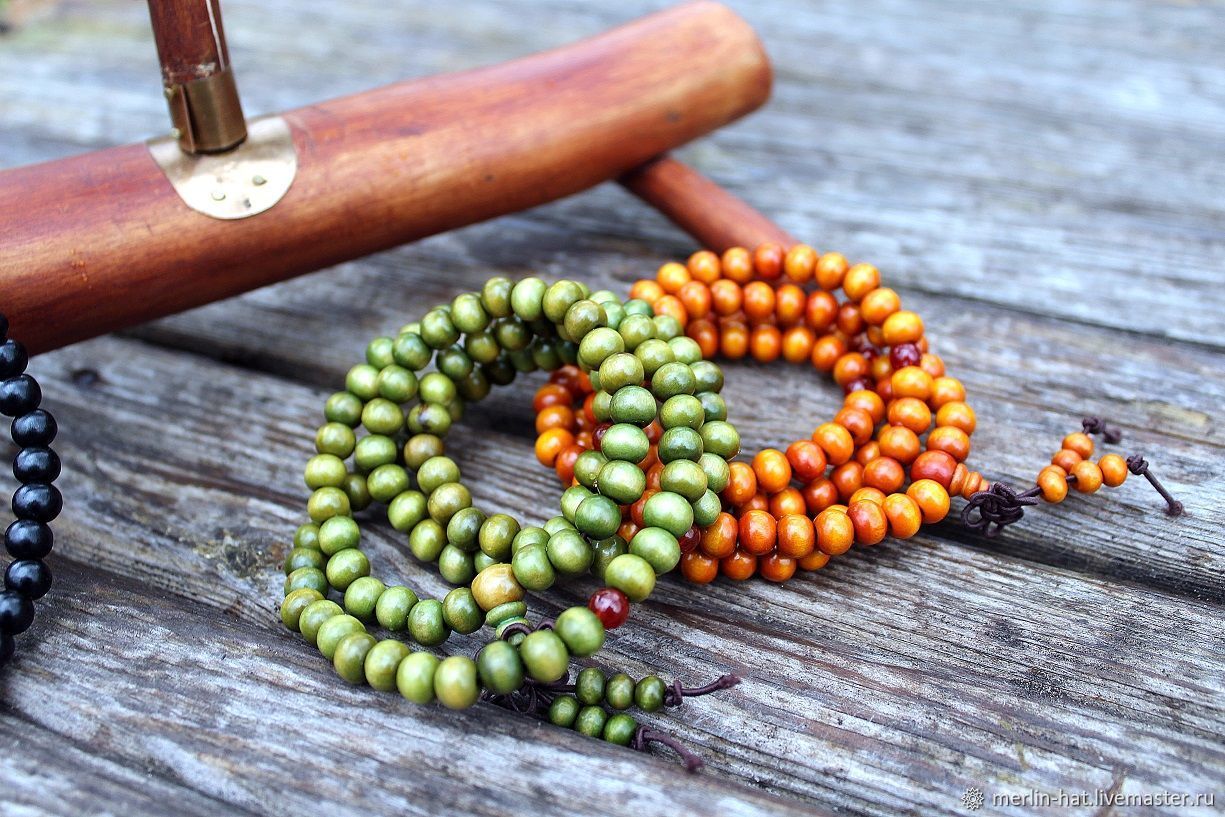In fact, rosaries have always been considered a religious instrument, which are used when reading prayers, for counting bows or other rituals, developing attention and maintaining concentration, setting rhythm, etc. However, for several decades they can also be seen as a stylish accessory, which emphasizes the image or adds some zest to the appearance.
A rosary is a closed ring of cord or ribbon (strong), onto which knots are tied, beads (grains), plates or other similar elements are strung. A variety of materials are used as raw materials to create grains:
- oak, ash, plum, bodhi and other types of wood;
- minerals, as well as crystals and precious stones - carnelian, agate, obsidian, garnet, amethyst, aventurine, etc.;
- pearls, corals, bones, glass, clay, plastic;
- fruits and seeds of plants.
And just like that around beads and many questions arise, and the main one is how many of them should be in the rosary.It will not be possible to give a definite answer, since different religions imply different quantities, for which there is an exact explanation.
Rosary beads are often complemented with other details in the form of pendants. For example, in Buddhism, a golden pearl is a sign of Buddha; in Krishnaism, a brush is hung from one grain - a symbol of Krishna with a peacock feather in his hair; and in Orthodoxy, a cross or medallion.
Buddhism
The number of grains in the rosary varies, and there can be many options. Most often this is 108 beads, but there may also be products with a different number - a divisor of 108: 54, 36, 27, 18 or 21. Usually they have pendants after 36 and 72 beads.

108 smooth beads correspond to the number of mental states or sinful desires of a person that can be overcome by reciting the rosary.
In general, if you look at this religious instrument of a Buddhist and count the grains, it is very easy to understand which movement the follower belongs to.
Hinduism
Usually 108, 54 or 50 beads. Rosary is a mandatory attribute of Indian deities - Lakshmi, Brahma, Vishnu, Shiva, Devi, Durga, etc.

Islam
Muslim religious instruments contain 99 (the number of names of Allah), 33 or 11 beads and a pendant. Traditionally, they include 11 beads, then a jumper (usually an oval-shaped grain, a flat circle), and then a similar sequence until a specific number of beads are used. The reason for this is simple - the Muslim prayer consists of 11 parts.

Christianity
Rosary beads are quite common among people who profess Orthodox Christianity. They are used by both priests and ordinary laymen, but some members of the clergy believe that this is an instrument exclusively for monks. In Christianity they appeared earlier than the 4th century.But initially it was a simple rope with tied knots, and this tool was called a vervitsa.

Catholicism
They have their own name - the rosary. They number 50 beads, which are divided into 5 decades. But products are known containing both 33 and 150 grains.
Orthodoxy
Usually there are 100 beads (considered a monastic instrument), but there can be rosaries with 33 grains (according to the number of Christ’s earthly years). The number of elements must be a multiple of 10 or 12.
Brojanica is a special type of rosary, popular in the states of the Balkan Peninsula (especially common in Serbia and Montenegro). Essentially, this is a strip knitted with a special weave. The material used is often sheep wool.
Old Believers
In the Old Believers, almost all agreements and interpretations have their own rosary - lestovka. Made from leather, made in the form of a ribbon. Includes 109 beads, called bobbins or steps, with tightly rolled rolls of paper inserted into them. Previously, each of them had Jesus' prayer written on it, but today this idea is practically not supported.
Any detail in the ladder has a spiritual symbolic meaning. In addition, there are products for men, women and even children.
Anglicanism
Anglican rosaries (they are also ecumenical) similarly have 33 elements (according to the number of years of Jesus’ earthly life - as in Orthodoxy), but are divided into groups (as in the Catholic rosary).
The groups, in turn, make up “weeks” of 7 small beads (4), separated by large cross-shaped beads (3). And attached to one of the large ones is an additional thirty-third (2) (so-called invocation) bead, to which a cross (1) is attached.
Lutheranism
Martin Lønnebo, a Lutheran priest, introduced his own type of rosary, which are called pearls of life.Traditionally, they consist of 18 beads, which may differ in appearance.
Neopaganism
Wicca, Asatru, Rodnoverie are the main movements where rosaries are also relevant. But in this case, there are no specific rules for the number of beads or their alternation, therefore each master makes the instrument at his own discretion, putting personal meaning and meaning into it.
Non-religious use of rosaries
Rosary beads can be used not only in religious rituals, but also as a stylish addition to an image. They are worn in different ways or in any way that suits them. For example, as beads or a bracelet, and some are even hung on the mirror in the car. The number of grains in such products, of course, can be very different. Vivid examples:
- Komboloi are special accessories popular among the Greeks. Their distinctive feature is that the long length of the thread is not occupied by beads. They are not used for counting prayers, like ordinary rosaries, but for throwing them in the hands. As a rule, these are 20 grains strung on a strong base.
- Boltukhs - there are no beads in the usual sense - these are flat rectangles in the form of a continuous ribbon. Their number is 13, but options with 8, 10 and 12 are also possible.


 1
1




